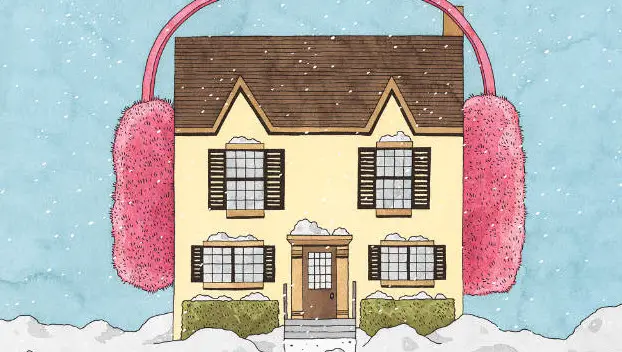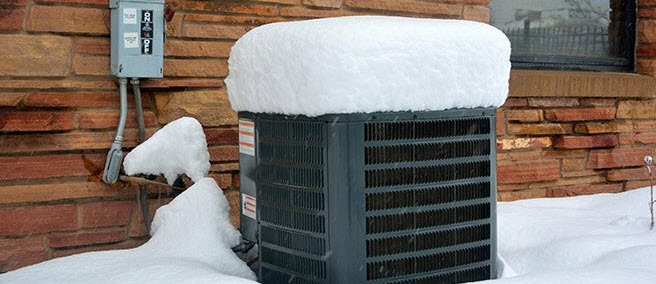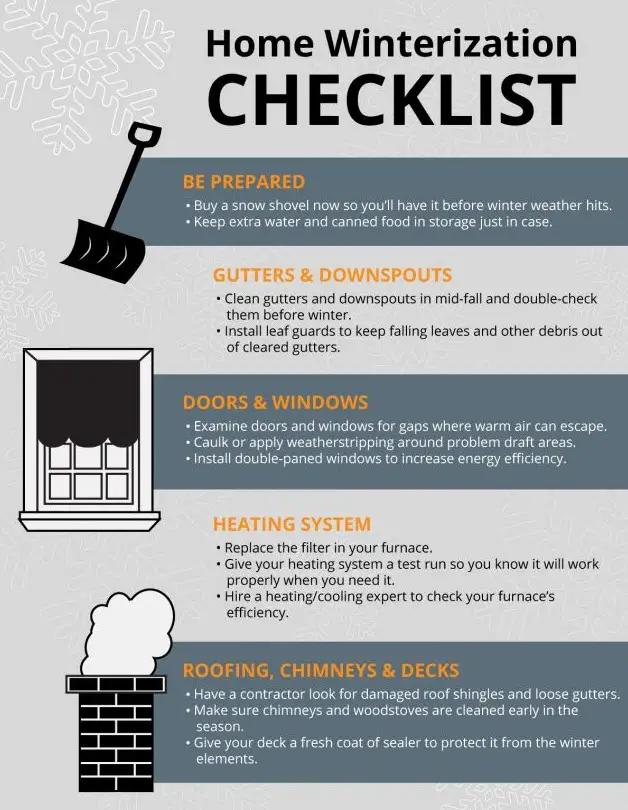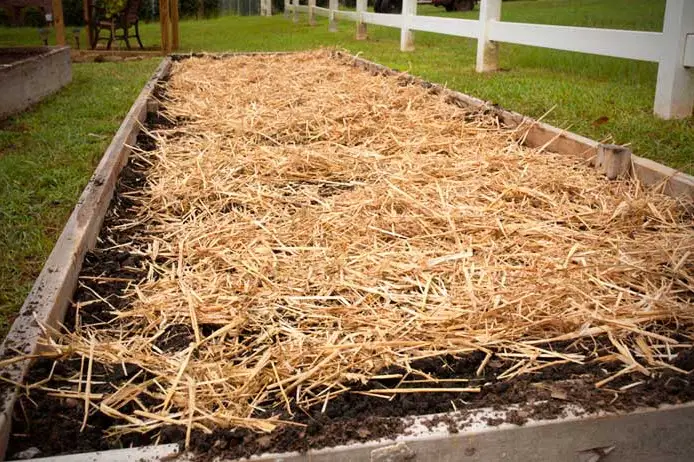
Page Contents
- How to prepare your home for the winter
- Take care of the heating system
- Yes, you also need to winterize the doors and windows!
- Yes, your roof also needs some preparation
- Winterize the sprinkler systems
- Landscape and the outdoor accessories- how to protect them during winter?
- Fall is the right time to prepare your garden for winter. Here’s how!
- Your lawn also needs preparation
- How to winterize your garden?
How to prepare your home for the winter
There’s no better time to get ready for winter than now. As the leaves are falling down, you should start preparing for the most wonderful time of the year. After all, installing some storm windows in 20 degrees weather is no picnic and it’s better to be safe than sorry. In addition, you should make time to prepare your sprinkler system as you most definitely don’t want to brush the snow from the frozen lines.
We all like checklists as they sure make it all a lot easier for us. Winterizing your home isn’t challenging, but you need to be meticulous so that you don’t skip any of the important steps. Taking care of each system around your house and even the plumbing or the roof isn’t something that you can do overnight, simply because you’re not going to have enough time for it. Planning ahead and making time for each step is going to have a warmer and more relaxed winter, for sure.
Take care of the heating system
The very first thing to do when it comes to the heating system is to check if you have heat every time you need it. However, you shouldn’t wait until the 1st night of Christmas to do it. You should do it in the fall, but don’t wait until October is over. Run a test for your heating system and see that all the systems are “GO”.
Here are the things to consider for a test run:
- Turn the thermostat to heat mode, choosing the 80 degrees setting for the test. You should be able to hear the furnace turn on. It’s only going to take a couple of minutes until warm air is going to blow. Turn your thermostat back to the previous setting in case the furnace it working just fine. In case of some malfunction, you should check it with a professional. You’re not going to be able to fix it on your own every time, so don’t hesitate to give a call to a service technician.
You shouldn’t forget that the heating system needs seasonal maintenance. You can do it on your own, or talk to the specialist technician.
- Make sure you install a clean and new air filter. It’s not difficult so you can do it alone.
- If you’re using oil or propane furnace, you need to see that the storage tank has enough fuel.
- Clear any obstacles from the heating vents as you want the air to flow in a freeway. Talk to a service technician so that he comes every year or two.
- Don’t forget to check for carbon monoxide leaks. Use an affordable test badge or install a battery-operated alarm. Whichever solution you decide to go with, it’s better to play it safe.
Make sure everything is fine with the wood-burning fireplace, chimney and flue
Truth be told, you’re not using the wood-burning fireplace or the chimney during the summer. Nevertheless, they may cause impressive cold air leaks and all sort of problems during the winter. The fireplace and the chimney do need some attention and you shouldn’t skip them from service before winter is all set in.
Here are some things to take under consideration:
- The chimney has to be clear so make sure that there are no nests from squirrels, birds or any other small animals.
- You need to see how the damper is working. It has to open and close entirely. It also has to lock when in the open/closed position.
- If you haven’t cleaned your fireplace chimney for a while, it’s better to call a professional chimney sweep. This is no DIY project to attend.
- Take a look at the chimney draft. It’s fundamental for the chimney to suck the smoke and the fire the right way. You can take a test for this. Roll some sheets of newspapers, lighting them in the fireplace (the fireplace damper has to in the open position). Everything is fine if the smoke rises up the chimney almost instantly. If that doesn’t happen, your chimney has an obstruction. You should call a professional for cleaning the chimney of creosote, debris and ash.
- Remember to take a look at the firebrick in the fireplace. You should fix any open mortar joints. The risk for the fire to spread in the stud wall through the open joints is quite high.
Take a look at the air conditioning as well

It’s quite common to forget about the condensing unit outside, even if it’s so important for the cooling system. As the winter comes, you should do a couple of things related to the air conditioning:
- Use a hose and set the spray head to the highest pressure. You should clean the fan blades and condensing coils as dirt and debris may damage it the condensing unit.
- You cannot leave the condensing unit without a cover as wet leaves and debris may lead to rusting. In addition, the internal elements may freeze as well. The condensing unit is designed for outdoor use, but you still need to protect it with a breathable waterproof cover. you’re going to expand its durability and maintain its performance for a good amount of time.
- In the case of window air conditioners, it’s better to remove and store them away throughout the winter. In case that’s not an option, you should close the vents and install an air conditioning cover, similar to the one used for the condensing unit.

Make sure you protect the pipes from freezing
Unfortunately, the risk for the plumbing to freeze is pretty important, so you can never want to take a chance on that. The freeze may cause the pipes to burst and you don’t want to spend the money for Christmas gifts on the plumbing instead. Make sure you cover them and go over our tips:
- In case you have some exposed water or drain piping in some uninsulated areas (the attics, crawlspace, outside walls), you should have insulated them with some foam insulation (to say the least). Do it all the way and wrap them with some electrical heating tape first and take care of the insulation afterwards.
- The outer faucets also may require you to turn off their water supply inside the house. You should also drain water from it, opening up the outside faucet. Get and install an insulated cover for the hose bib as well. Don’t forget to disconnect the garden hoses from the outside faucets and the silcocks. You also need to drain them when stored outside.
- When you’re shutting down your residence for the winter, you need to shut off the water supply, draining the plumbing system. The damage may be important if a leak is going to happen while you’re not there.
Yes, you also need to winterize the doors and windows!
Cold air from air leaks around your windows and doors may lower the temperature in the house. Poor insulation in the ceiling and in the walls may have the same effect too. You can keep your heating bill under control with some easy-peasy weather stripping:
- Close the windows on a windy day, trying to notice any air leaks. An incense stick is going to be very useful too, especially if it has a nice scent to it. Pay attention to the smoke trail. When it’s not vertical anymore, it means you have to deal some air leak. Most of the time, you’re going to find air leaks where the window is hinged or where it slides/meets another window. Air leaks often appear in the case of two panels of a double-hung window.
- Use some tape plastic to seal the windows, even though it’s not the cheapest solution. This option isn’t the prettiest one either. You’re also going to reduce much of the natural light like this (and we all want more of it). Some shrink-wrap type of plastic seal may be the better option.
- The easiest and cheapest choice is to use some rope caulk, pressing it into all the joints where you notice air leaks.
- As for the doors, you should check for weather stripping on the side and bottom of all doors around the house. Install weather stripping on all leaking doors.
Never skip the insulation
Insulating your home is essential, but we’re not going to go over the details for now. Here are some other areas where you should consider using insulation.
- Insulate the exterior outlets. Get cheaper foam sealing gaskets
- Don’t forget to insulate the hot water tank with an insulating blanket that is easy to find in most hardware stores
- Not everyone uses the fireplace. Even so, some air leaking may appear in that area, so a piece of fiberglass insulation, stuffing it into your fireplace, right behind the glass doors for blocking the cold air is going to do the trick. Keep in mind to remove it when you’re making a fire.
Yes, your roof also needs some preparation
Once you took care of everything inside the house, you should also go outside for winterizing your residence. Take a good look at your roof and hire someone if you don’t like doing it on your own. Make sure you wear well-fastened shoes that come with non-skid soles if you’re going to do it yourself.
- See if there are any missing/damaged shingles on your roof. Replace the damaged ones.
- The downspouts and gutters have to be clean and with no leaves. If some wet leaves are going to remain in the gutters during the winter, they may add important volume and weight to the gutter as they’re going to freeze and lead to damage.
- Make sure you take a look around the chimney or various roof projections. You may have to do some repairs, so don’t postpone it.
Winterize the sprinkler systems
Don’t forget about the sprinkler system, even though you’re not going to use it any time soon.
- Don’t winterize the sprinkler system later than the end of October
- Turn off the water supply and blow compressed air through the sprinkler lines. This way, you’re going to purge them of water, lowering the risk for freezing and even bursting.
Landscape and the outdoor accessories- how to protect them during winter?
Installing the Christmas decoration isn’t the only thing you can do for your yard. As a matter of fact, that may be the very last thing to do for your garden.
You need to take care of the grass, deck and all the other outdoor accessories you have around your house.
- Protect the patio furniture and cover it
- It’s not a bad idea to give your deck a fresh coat of sealer just before the first snow comes.
- Drain all water fountain and unplug the pumps too
- Drain the gas from the lawn mower. Go with the lazy style and let it run until it’s all out of gas.
Fall is the right time to prepare your garden for winter. Here’s how!
When it comes to gardening, simply protecting it isn’t going to do it so you may plan some work in the garden, preparing it for the cold weather. Here are some of the things you can do this time of the year:
- Bulbs, bulbs
Fall is in fact a great time to plant some spring-blooming flower bulbs. Tulips, daffodils, grape hyacinth and crocus are nice options. You don’t even have to work that hard for preparing your garden for the blooming spring.
You can also plant some garlic and shallots this time of the year, even if you’re only going to be able to harvest it next summer. The wait is going to worth, for sure.
- Use colors
some pansies, foliage plants and mums are great to plant as they’re going to flourish in cool temperatures. They can even handle some frosting times. They’re going to bring some nice colors to your garden, which is always nice to have.
- Restore your plants
Fall is a great season for separating the spring blooming perennials from the summer ones. You should go with the plants that have a vigorous growth and place the less-vigorous ones in the center. Use a root saw or a sharp spade for separating them into clumps. Replant in different holes afterwards.
- Plant
The high moisture and cooler temperatures during the fall are great for sustaining the recently transplanted/ planted trees and shrubs to adjust before continuing to grow. Even if the tops of the plants aren’t going to show any growth, the roots are actually working as it’s going to take a while until the plant goes dormant.
- Why not sow a new crop?
Fall is great for sowing some lettuce seeds and spinach for a late-fall crop. You may extend the season and cover the straw when it starts to freeze. You should cover the root crops with some straw, easing the future winter harvests.
- Clean up your yard
Remove the dead annuals and the fallen fruits. Try not to overdo it with the perennials. You want a cluster-free appearance for your garden. This is going to lower the risk of pests overwintering in the debris and leading to several problems once winter is gone.
- Collect the leaves
You don’t want the rake leaves to smother the grass, especially if we’re talking about maple leaves (or any other large leaves). Better yet, mow your lawn and get the mix of shredded leaves, using it as mulch for shrub and flower beds.
- Leave some plants be
Even if cutting back on perennials isn’t the worst idea, you should leave some during the winter time. The thick-stemmed plants (mums, taller sedums, Russian sage) and ornamental grasses are good options.
- Build a composite pile

You may use the leaves for a green kitchen scrap. The combination of green and brown materials is going to speed up the composting process. Don’t use dairy products or compost meat, as you’re going to attract rodents like this. It’s also safer to get rid of infested and diseased plants. They may seed in the trash and you don’t want that.
- Prepare the next growing season
You need to clean and prepare your garden tools before storing them away. Drain and disconnect the hose, putting it away, along with the garden tools. Wipe down the outdoor furniture and use a cover for protecting it throughout the winter.
- Take a look at the pond
Don’t forget about the pond and clean it from fallen leaves. It’s also wise to drain the water by 25 5o 50%. Add some bacterial additive to the water so that you boost the decomposition of organic matter and store away the pumps.
- Make sure you store the summer bulbs
You may still save some of the summer bulbs (dahlia, canna and gladiolus) for the next year. You should dig them up after the first frost, drying the root structures for several days. Shake off the excess soil and store them in peat moss or sawdust. You should store them in a dark basement or root cellar.
- Grow a cover crop
If the soil is bare, you should grow some living mulch. Sow some clover, rye or any other cover crop that grows fast. You may turn the seasonal cover crop into the soil later in the spring.
- Put aside the good seeds
If some of the annuals really did make an impression on you, you should collect the seeds, storing them for next year. Place the seeds in some paper envelopes and put the envelopes in glass jars. This is a great solution for the open-pollinated varieties and not so much for the modern hybrids.
Your lawn also needs preparation
You also need to winterize your lawn so here the tips to keep in mind:
- Aerate the turf
You may very well do this during spring, but you should also do it in fall. You may use a rent power equipment or a manual aerator for it.
- Reseed the bare spots
Fall comes with cool temperature and plenty of moisture, so it’s easy to repair some bare spots in the lawn. Loosen the soil by scratching its surface. Continue with sprinkling grass seeds and covering it with straw or mulch. This is going to keep birds away. Until the grass is established, you need to water it constantly.
- Remove the weeds
Use a dandelion tool or remove by hand the weeds. Use some broadleaf herbicide as you want to keep ground ivy and dandelion away from your lawn.
- Spread the compost
Once your lawn is aerated, you need to spread compost as it’s easier like this to fill the gaps from the removed plugs. Fall rain is going to sustain the beneficial microbes and nutrients work deep into the soil.
- Fertilize
You should strengthen the turf before winter so a fall fertilizing of the lawn is going to do the trick.
How to winterize your garden?
Here are some other things that you need to do before winter is here:
- Keep the pests away from your plants
Use wire-mesh screening (hardware cloth) and protect the trees with it. The animals aren’t going to browse on foliage if you do so.
- Avoid frost cracking and wrap tree trunks
Wrapping the tree trunks is going to protect the thin-barked species during winter. The trees warm up during the day, but the bark may split at night from the freeze. You should use paper tree wrap and begin an inch below soil level, moving up toward the lowest branches. Get some duct tape for better results. Keep in mind to remove it in spring so that new growth is possible again. You can prepare your trees with tree professional Nashville.
- Take care of the rosebushes
New shrub roses don’t need winter protection, but you’re going to have to take care of older hybrid teas and floribundas. Use rose cones and make a cylinder, filling it with chopped leaves for the winter to come. When spring comes, simply remove it.
- Maintain moisture level
The risk for the evergreens to dry during winter is pretty high so you need to make sure that your plants are well watered. Use a spray with ant desiccant or wrap your plants with a double layer of burlap.
- Make sure you water them
If you’re going through a dry fall, you may have to water the plants even after they go dormant. You need to water them until the ground freezes. In a warmer climate, you only have to water them if it’s not raining.
 A Very Cozy Home Home Decor Tips and Ideas
A Very Cozy Home Home Decor Tips and Ideas 